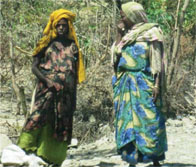15.4.3 Snowball sampling
Snowball sampling is often used when working with populations that are not easily identified or accessed. The process involves building up a sample through referrals. You start with one or two key individuals who you believe know a lot about the subject you are investigating, and you ask them if they know other people who also know a lot about the topic of interest (Figure 15. 6). You then ask those individuals for further recommendations of others who may know a lot about the topic, and so on. In this way a sizeable sample may be obtained. It is called ‘snowball’ sampling because when a small ball of snow begins to roll down a snow-covered hillside, it gathers more snow as it travels and gets larger and larger over time – just like the snowball sample in a research study.

Supposing you wanted to investigate a particular type of rare birth defect. You have only come across two mothers in your kebele who have children with this defect. How might you investigate this defect?
You could use snowball sampling for investigating this birth defect. You could start by interviewing the two mothers who are known to you, and ask them if they know of other mothers with children with the same birth defect. If they do, you could locate these mothers and ask them if they know of other who are similarly affected. In this way it may be possible to build up a sizeable number of mothers to include in your sample.
15.4.2 Quota sampling
